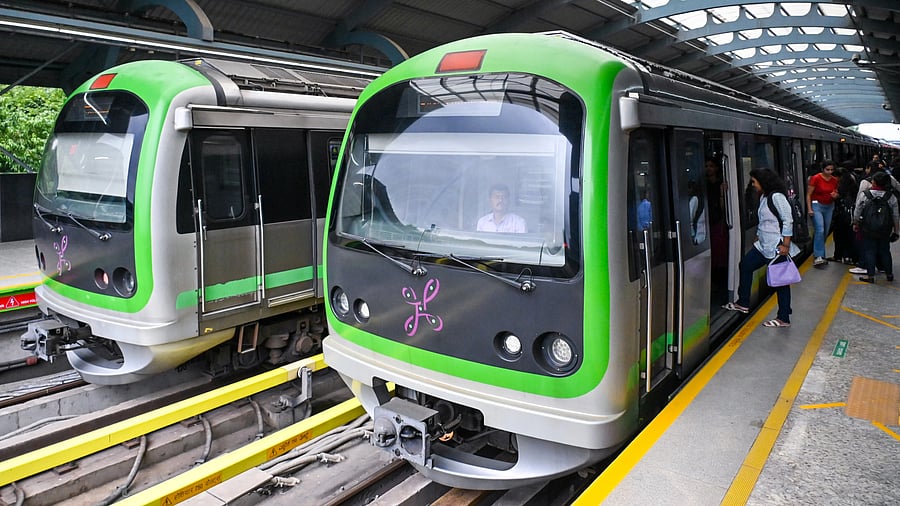
A view of Namma Metro's Green Line trains at Rastriya Vidyalaya Metro Station in Bengaluru.
Credit: DH File Photo
Bengaluru: Tamil Nadu’s plan to build South India’s first interstate metro line connecting Bengaluru and Hosur appears to have hit a dead end, with the BMRCL saying it is “technically not feasible”.
The development comes as the Bangalore Metro Rail Corporation Limited (BMRCL) has lined up an ambitious expansion plan, preparing feasibility reports for four extensions, examining three more extensions and one new line.
These studies were commissioned after the Centre asked the BMRCL to prepare a master plan to expand the Bengaluru metro network to 470 km, which will help expedite approvals.
The BMRCL has informed the Karnataka government that the 23-km Hosur-Bommasandra corridor will use different traction (electrical power) systems and cannot be integrated into Namma Metro
A feasibility study by Chennai Metro Rail Limited (CMRL) proposed linking Hosur with Bommasandra using a 25 kV AC overhead traction.
The BMRCL conducted its own study to extend the metro from Bommasandra to Attibele, the last city suburb towards Tamil Nadu. This 11-km line, like the rest of the Namma Metro network, will use the 750 V DC third rail traction.
“Building a continuous line from Bommasandra to Hosur is not technically feasible. The Hosur line just cannot be integrated into our system,” a senior BMRCL official with direct knowledge of the matter told DH. “We’ve shared our opinion with the state government, which will take the final decision.”
Tamil Nadu has backed the Hosur-Bommasandra metro project as part of its push to develop the industrial town.
However, the idea of a direct metro link between Bengaluru and Hosur has faced opposition in Karnataka, with critics arguing that it would benefit Hosur more than Bengaluru and further burden the city.
If Tamil Nadu proceeds with a metro up to the Karnataka border — about 12 km from Hosur — Attibele may get two stations, spaced about 300 metres apart.
“The stations can be connected by a foot overbridge. That’s the most feasible option,” the official said.
The Bommasandra-Attibele line is one of four Namma Metro extensions under Phase 4. It will have 7-8 stations.
The BMRCL has also studied extending the Green Line from Madavara to Tumakuru (59.6 km). The state has directed it to prepare the Detailed Project Report (DPR) for this Rs 20,896-crore line with 25 stations.
The Green Line’s southern extension — from Silk Institute to Harohalli on Kanakapura Road — will span 24 km with 18 stations. “Since villages are scattered in that area, there will be fewer stations,” the official added.
The Purple Line’s western extension, from Challaghatta to Bidadi, will cover 15 km and have 13 stations.
Feasibility reports for all these four extensions have been prepared by Hyderabad-based Aarvee Associates Architects Engineers and Consultants Pvt Ltd. “The draft reports are ready and will be finalised by Oct-end,” the official added.
In addition, the BMRCL is examining three more extensions and one new line.
These include: Blue Line extension (Doddajala-Devanahalli, 10 km), Purple Line extension (KR Puram-Hoskote, 16.3 km), Silver Line extension (Kadabagere-Tavarekere village, 6 km), and a new 68-km line from Kalena Agrahara to Kadugodi Tree Park via Bannerghatta, Jigani, Attibele, Sarjapur, Dommasandra and Varthur Kodi.
These studies were commissioned after the Ministry of Housing and Urban Affairs (MoHUA) asked the BMRCL to prepare a master plan expanding the Bengaluru metro network to 470 km on a par with Delhi’s network.
The reports are expected shortly, the official added.
“Preparing the master plan will help us get approvals in one go and speed up construction,” another senior BMRCL official said.
“Instead of proposing short 30–40 km lines, we’ve been asked to plan a 200 km-plus expansion, given Bengaluru’s severe traffic issues.”
Together, the seven extensions and new line add up to 210.9 km, taking Namma Metro’s total planned network to 467.69 km — almost equal to the Delhi-NCR metro’s planned 467 km.